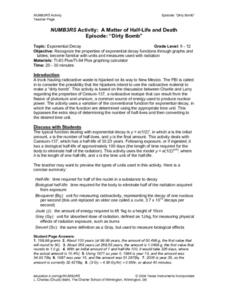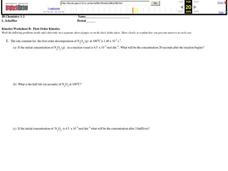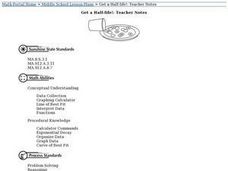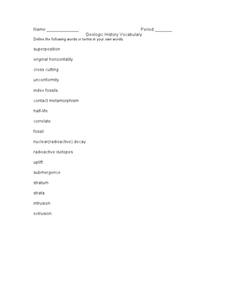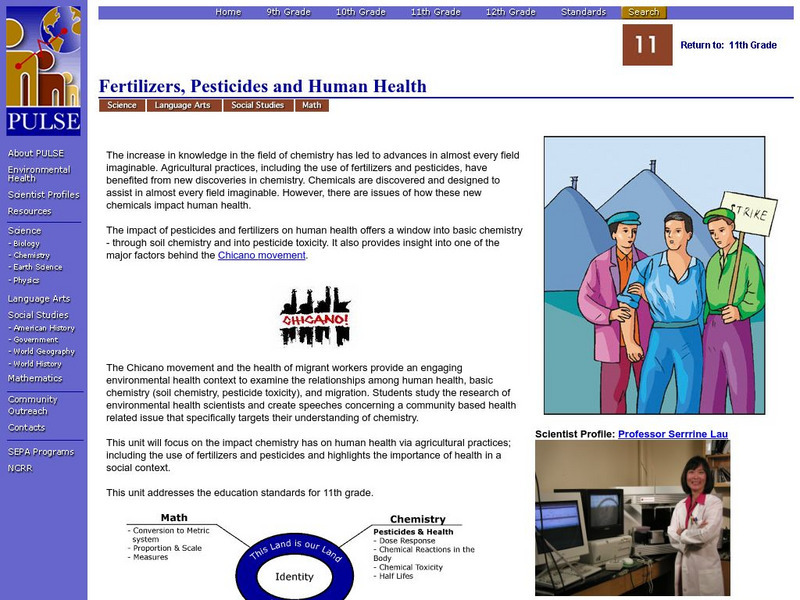Curated OER
Six Exponential Decay Problems
In this exponential model worksheet, students solve six exponential decay multiple choice questions and one free-response half life question. The solutions are provided..
Curated OER
Absolute Dating/Radioactive Dating
Students explore radioactive decay. In this radioactive atoms lesson students complete a lab to help them understand the relationship between radioactive atoms vs stable atoms.
Curated OER
Radiation Reassessed
Young scholars investigate the dangers of radiation by exploring recent nuclear tragedies. In this scientific debate activity, students define the idea of radiation "half life" and determine if low doses of radiation are truly damaging...
Curated OER
NUMB3RS Activity: A Matter of Half-Life and Death
Young scholars investigate exponential decay. Students explore the biological half-life of Cesium-137. Young scholars investigate the Goiania Accident of 1987 which is considered one of the worst incidents in the history of the Atomic...
Curated OER
Nuclear Chemistry
In this nuclear chemistry worksheet, students solve nine decay problems. They determine what forms in each problem given the radioactive element.
Curated OER
Bellwork April 12-16
In this bellwork worksheet, students answer questions about the Paleozoic and Mesozoic eras. They answer questions about fossils, half life, and radioactive material.
Curated OER
Measuring Absolute Time
In this absolute time learning exercise, students answer eleven questions about ways to measure the age of fossils. They define half-life, answer questions about radioactive dating, tree rings and varves.
Curated OER
Radioactivity
In this radioactivity worksheet, students write the mass number and atomic number for the missing element in the reactions. Students identify the isotope that is more stable and determine the half-life of the isotope. This worksheet has...
Curated OER
Experimental Rate Law
In this reaction rate worksheet, students determine the molecularity of a reaction plus show that the predicted rate law equals the experimental rate law. This worksheet has 3 problems to solve.
Curated OER
First Order Kinetics
In this kinetics worksheet, learners determine the concentration and half life of compounds at a specific rate constant. This worksheet has 4 problems to solve.
Curated OER
Chemical Reactions
In this chemical reactions worksheet, students write rate expressions, determine the order of reactants and the rate law, and calculate the rate constant from data. Students calculate the half-life for given reactions. This worksheet has...
Curated OER
Absolute Ages of Rocks
In this ages of rock worksheet, students review the processes involved with determining the ages of rocks which includes the radioactive decay of carbon-14. This worksheet has 5 matching and 5 short answer questions.
Curated OER
work in pairs for the activities of this lesson which include researching and identifying butterflies, writing, and a brief oral presentation.
Students explore the concepts of rdioactive decay and dating. They generate a radioactive decay table, use their data to plot a decay graph, develop the concept of half-life, and then use the graph to find the age of a mummified seal in...
Curated OER
Radioactive Decay
Students explore what radioactive decay is and are able to relate it to the concept of half-life. They are given 100 green beads that represent radioactive atoms and 100 white beads that represent stable, non-radioactive daughter atoms....
Curated OER
Get a Half-life!
Students explore decay functions and the half-life of a substance. Through an M&M activity with calculators, students collect and graph data. They determine the linear, quadratic and exponential functions of the graph. Students...
Curated OER
Radiation
Students distinguish between natural and man-made radiation. They measure radiation using a Geiger counter and investigate footprints of radiation.
Curated OER
Get a Half Life!
Eighth graders use M&M's to experiment with data. They use a graphing calculator to determine the best equation for their data; linear, quadratic or exponential. They analyze the data to find the half-life of their M&M's.
Curated OER
Radioactive Decay/Half Life
Young scholars demonstrate radioactive decay using candy corns. For this Physics lesson, students make predictions, collect data and form conclusions about patterns in radioactive decay.
Curated OER
Geological History Vocabulary
In this geological history worksheet, high schoolers define 17 terms associated with index fossils, nuclear decay, and radioactive decay.
University of Arizona
Pulse: Fertilizers, Pesticides and Human Health
A cross-curricular unit to explore how human health is impacted by pesticides and fertilizers. The lesson comes out of the Chicano movement which studies the health of migrant workers due to agricultural practices. The unit was developed...
Khan Academy
Khan Academy: Mcat: Physical Processes: Atomic Nucleus: Decay Graphs and Half Lives Article
Explains how scientists can tell when radiation has been leaked, how to read a decay graph, what we mean by a half-life, and what carbon dating is.
Michigan State University
Michigan State University: Decay Constants and Half Lives
This site from the Michigan State University provides a short review of decay constants and half-lives.





